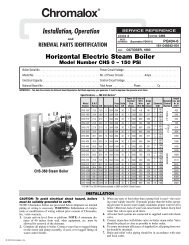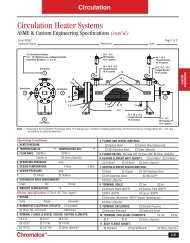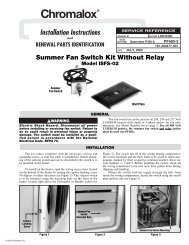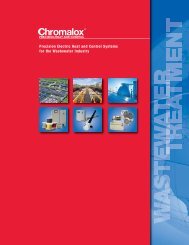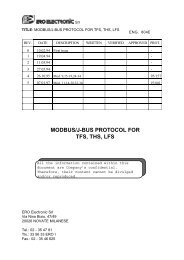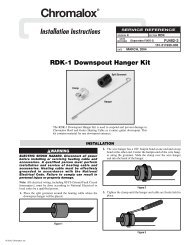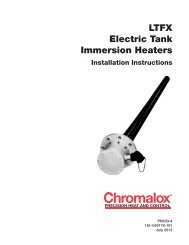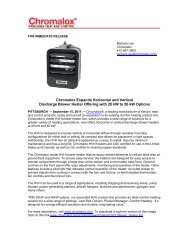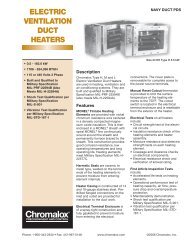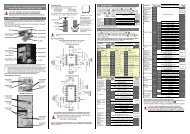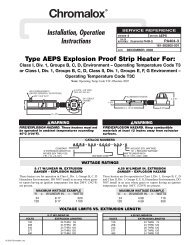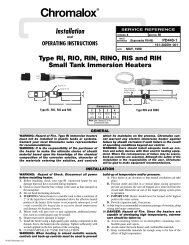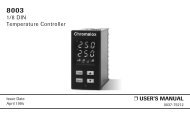Cold Weather Catalog - Chromalox Precision Heat and Control
Cold Weather Catalog - Chromalox Precision Heat and Control
Cold Weather Catalog - Chromalox Precision Heat and Control
- No tags were found...
Create successful ePaper yourself
Turn your PDF publications into a flip-book with our unique Google optimized e-Paper software.
TechnicalTechnical InformationHazardous Locations & Electric <strong>Heat</strong>er ApplicationsHazardous Locations (NEC) 5Articles 500 to 504 in the National ElectricalCode (NEC) defi ne the requirements forelectrical <strong>and</strong> electronic equipment <strong>and</strong> wiringin locations where fi re or explosion hazardsmay exist. In Article 500, hazardous locationsare categorized by class. Classes are defi nedas follows:Class I — Groups A, B, C & D - Division1 or 2 Temperature Rating T1 - T6Class II — Groups E, F & G - Division 1 or 2Temperature Rating T1 - T6Class III — Division 1 or 2Class I, II & III (NEC 500)Hazardous location classes are identifi edbased on the explosive material present. Thefollowing information is an interpretation <strong>and</strong>summary of each class <strong>and</strong> a discussion ofsome of the conditions to be considered whenusing electric heaters in these areas. Refer tothe National Electrical Code <strong>and</strong> local authoritiesfor the proper classifi cation <strong>and</strong> requirementsof a specifi c hazardous location.Class I Locations (Gases) are areas wherefl ammable gases or vapors are or may bepresent in the air in quantities suffi cient toproduce explosive or ignitable mixtures(NEC 500-5).Class II Locations (Dust) are areas where thepresence of combustible dust presents a fi reor explosion hazard (NEC 500-6).Class III Locations (Fibers) are areas madehazardous because of the presence of easilyignitable fi bers or fl yings, but in whichsuch fi bers or fl yings are not likely to be insuspension in the air in quantities suffi cient toproduce ignitable mixtures (NEC 500-7).Group Classification, Class I & II 6Certain chemicals create higher explosivepressures <strong>and</strong> more heat than others whenignited. In Class I <strong>and</strong> II hazardous locations,chemical families are further classifi ed byGroups. Group classifi cation involves determinationof the maximum explosion pressures,the maximum safe clearance or gap betweenclamped enclosure joints <strong>and</strong> the minimum ignitiontemperature of the atmospheric mixturefor a particular chemical.214NEC requires that any electrical equipmentapproved for use in a hazardous location mustbe approved for the class <strong>and</strong> for the specifi cgroup (gas or dust) that will be present.Groups are identifi ed as A, B, C, D, E, F <strong>and</strong> G<strong>and</strong> are explained as follows:Class I — Gases 6 (NEC 500-3a)Combustible <strong>and</strong> fl ammable gases <strong>and</strong> vaporsin Class I are sub-divided into four groups A,B, C <strong>and</strong> D. Group A gases create the mostexplosive pressure <strong>and</strong> therefore are the mostdiffi cult to contain. Group B is next, then GroupC with Group D being the lowest. Third partylistings of electrical equipment for Group A or Bare more diffi cult to obtain than Group C or D.Individual gases are further defi ned by ignitiontemperature (see Temperature Ratings).Group A —Gases include: Ignition Temperature°C °FAcetylene 305 581Group B —Gases include: Ignition Temperature°C °FButadiene 1 420 788Ethylene oxide 2 429 804Hydrogen & mfg 400 752gases > 30% hydrogen (by volume)Propylene oxide 3 449 840Group C —Gases include: Ignition Temperature°C °FAcetaldehyde 175 347Cyclopropane 500 932Diethyl ether 160 320Ethylene 450 842Dimethyl hydrazine 249 480Group D — is the largest group <strong>and</strong> includesmany of the common petroleum products.Gases include: Ignition Temperature°C °FAcetone 465 869Alcohol’s1-butanol (butyl) 365 689Amyl alcohol 300 572Butyl alcohol (ter) 480 896Ethanol (ethyl) 356 689Isobutyl alcohol 427 800Isopropyl alcohol 399 750Methanol (methyl) 385 725Propyl alcohol 440 824Ammonia 3 651 1204Benzene 560 1040Butane 405 761Ethane 515 959Gases include: Ignition Temperature°C °FEthyl acetate 427 800Ethylene dichloride 413 775Gasoline(56 - 60 octane) 280 536(100 octane) 456 853Heptanes 280 536Hexanes 225 437Isobutyl acetate 421 790Isoprene 220 428Methane (Nat. gas) 482/632 900/1170Methyl ethyl ketone 516 960Petroleum naphtha 4 288 550Octanes 220 428Pentanes 260 500Propane 450 842Vinyl acetate 427 800Vinyl chloride 472 882Xylenes 530 986Notes —1. Group D equipment may be used for thisatmosphere if isolated in accordance withSection 501-5(a) by sealing all conduit(s)1/2 inch or larger (within 18 inches of theenclosure).2. Group C equipment may be used for thisatmosphere if isolated in accordancewith Section 501-5(a) by sealing allconduit(s) 1/2 inch or larger (within18 inches of the enclosure).3. For Classifi cation of Ammonia Atmospheressee Safety Code for MechanicalRefrigeration (ANSI/ASHRAE 15-1992)<strong>and</strong> Safety Requirements for the Storage<strong>and</strong> H<strong>and</strong>ling of Anhydrous Ammonia(ANSI/CGA G2.1-1989).4. Also Known By the synonyms benzine,ligroin, petroleum ether or naphtha.5. NEC <strong>and</strong> National Electrical Code areregistered trademarks of the National FireProtection Association.6. For a Complete List defi ning properties offl ammable liquids, gases, solids or dusts,refer to the latest edition of NFPA 325,NFPA 497 or NFPA 499.




